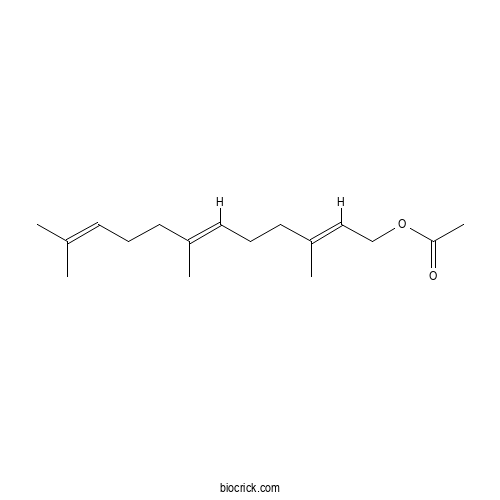(2E,6E)-Farnesyl acetateCAS# 4128-17-0 |

- (2Z,6E)-Farnesyl acetate
Catalog No.:BCX0433
CAS No.:40266-29-3
Quality Control & MSDS
3D structure
Package In Stock
Number of papers citing our products

| Cas No. | 4128-17-0 | SDF | Download SDF |
| PubChem ID | 638500 | Appearance | Liquid |
| Formula | C17H28O2 | M.Wt | 264.4 |
| Type of Compound | Sesquiterpenoids | Storage | Desiccate at -20°C |
| Solubility | Soluble in Chloroform,Dichloromethane,Ethyl Acetate,DMSO,Acetone,etc. | ||
| Chemical Name | [(2E,6E)-3,7,11-trimethyldodeca-2,6,10-trienyl] acetate | ||
| SMILES | CC(=CCCC(=CCCC(=CCOC(=O)C)C)C)C | ||
| Standard InChIKey | ZGIGZINMAOQWLX-NCZFFCEISA-N | ||
| Standard InChI | InChI=1S/C17H28O2/c1-14(2)8-6-9-15(3)10-7-11-16(4)12-13-19-17(5)18/h8,10,12H,6-7,9,11,13H2,1-5H3/b15-10+,16-12+ | ||
| General tips | For obtaining a higher solubility , please warm the tube at 37 ℃ and shake it in the ultrasonic bath for a while.Stock solution can be stored below -20℃ for several months. We recommend that you prepare and use the solution on the same day. However, if the test schedule requires, the stock solutions can be prepared in advance, and the stock solution must be sealed and stored below -20℃. In general, the stock solution can be kept for several months. Before use, we recommend that you leave the vial at room temperature for at least an hour before opening it. |
||
| About Packaging | 1. The packaging of the product may be reversed during transportation, cause the high purity compounds to adhere to the neck or cap of the vial.Take the vail out of its packaging and shake gently until the compounds fall to the bottom of the vial. 2. For liquid products, please centrifuge at 500xg to gather the liquid to the bottom of the vial. 3. Try to avoid loss or contamination during the experiment. |
||
| Shipping Condition | Packaging according to customer requirements(5mg, 10mg, 20mg and more). Ship via FedEx, DHL, UPS, EMS or other couriers with RT, or blue ice upon request. | ||

(2E,6E)-Farnesyl acetate Dilution Calculator

(2E,6E)-Farnesyl acetate Molarity Calculator
| 1 mg | 5 mg | 10 mg | 20 mg | 25 mg | |
| 1 mM | 3.7821 mL | 18.9107 mL | 37.8215 mL | 75.643 mL | 94.5537 mL |
| 5 mM | 0.7564 mL | 3.7821 mL | 7.5643 mL | 15.1286 mL | 18.9107 mL |
| 10 mM | 0.3782 mL | 1.8911 mL | 3.7821 mL | 7.5643 mL | 9.4554 mL |
| 50 mM | 0.0756 mL | 0.3782 mL | 0.7564 mL | 1.5129 mL | 1.8911 mL |
| 100 mM | 0.0378 mL | 0.1891 mL | 0.3782 mL | 0.7564 mL | 0.9455 mL |
| * Note: If you are in the process of experiment, it's necessary to make the dilution ratios of the samples. The dilution data above is only for reference. Normally, it's can get a better solubility within lower of Concentrations. | |||||

Calcutta University

University of Minnesota

University of Maryland School of Medicine

University of Illinois at Chicago

The Ohio State University

University of Zurich

Harvard University

Colorado State University

Auburn University

Yale University

Worcester Polytechnic Institute

Washington State University

Stanford University

University of Leipzig

Universidade da Beira Interior

The Institute of Cancer Research

Heidelberg University

University of Amsterdam

University of Auckland

TsingHua University

The University of Michigan

Miami University

DRURY University

Jilin University

Fudan University

Wuhan University

Sun Yat-sen University

Universite de Paris

Deemed University

Auckland University

The University of Tokyo

Korea University
- 4,4'-(1,3-Dimethylbutylidene)diphenol
Catalog No.:BCX0389
CAS No.:6807-17-6
- 14,15,16-Trinorlabda-8(17),11-dien-13-oic acid
Catalog No.:BCX0388
CAS No.:917078-12-7
- Sclerone
Catalog No.:BCX0387
CAS No.:19638-58-5
- Malformin C
Catalog No.:BCX0386
CAS No.:59926-78-2
- Gnetuhainin I
Catalog No.:BCX0385
CAS No.:308105-06-8
- Asperazine
Catalog No.:BCX0384
CAS No.:198953-76-3
- Triptotriterpenic acid C
Catalog No.:BCX0383
CAS No.:123914-32-9
- Deacetylnomilin
Catalog No.:BCX0382
CAS No.:3264-90-2
- Oxytroflavoside G
Catalog No.:BCX0381
CAS No.:1391144-89-0
- Diferuloylputrescine
Catalog No.:BCX0380
CAS No.:42369-86-8
- Versicolactone B
Catalog No.:BCX0379
CAS No.:108885-62-7
- Madolin U
Catalog No.:BCX0378
CAS No.:327185-00-2
- Excoecafolin C
Catalog No.:BCX0391
CAS No.:1643370-00-6
- n-Butyl α-D-fructofuranoside
Catalog No.:BCX0392
CAS No.:80971-59-1
- Tetrahydrorhombifoline
Catalog No.:BCX0393
CAS No.:3382-84-1
- 4''-O-Glucosyl-17α-deacetyltanghinin
Catalog No.:BCX0394
CAS No.:114612-75-8
- Levulinic acid
Catalog No.:BCX0395
CAS No.:123-76-2
- 17α-Deacetyltanghinin
Catalog No.:BCX0396
CAS No.:111614-46-1
- 6-Aminoquinolyl-N-hydroxysuccinimidyl carbamate
Catalog No.:BCX0397
CAS No.:148757-94-2
- Disporopsin
Catalog No.:BCX0398
CAS No.:1430334-05-6
- 8-Methyldisporopsin
Catalog No.:BCX0399
CAS No.:1671098-51-3
- 8-Methyldisporopsin 4'-methyl ether
Catalog No.:BCX0400
CAS No.:1589545-88-9
- 8-Methyl-2'-deoxydisporopsin
Catalog No.:BCX0401
CAS No.:1671098-52-4
- Disporopsin 4'-methyl ether
Catalog No.:BCX0402
CAS No.:1671098-53-5
The male-produced aggregation pheromone of the bean flower thrips Megalurothrips usitatus in China: identification and attraction of conspecifics in the laboratory and field.[Pubmed:32246573]
Pest Manag Sci. 2020 Sep;76(9):2986-2993.
BACKGROUND: Thrips, Megalurothrips usitatus, usually display aggregation behavior, which is probably mediated by a male-produced aggregation pheromone. Aggregation pheromones are species-specific, and can be used to develop commercial lures for monitoring and mass-trapping of pests. The active components of the aggregation pheromone for four thrips species have been identified. However, the components of M. usitatus-produced aggregation pheromone are still not clear. RESULT: Y-tube olfactometer assays showed that both male and virgin female M. usitatus were significantly attracted to male but not female volatiles. This was additionally supported by electroantennogram (EAG) assays. Coupled gas chromatography-electroantennogram detection (GC-EAD) showed that one component of male-specific odors elicited a significant electrophysiological response. This compound was characterized as (2E,6E)-Farnesyl acetate, which is structurally different from the active components of the aggregation pheromones of other reported thrips species. Electroantennal responses of M. usitatus increased with increasing doses of synthetic (2E,6E)-Farnesyl acetate. Additionally, this compound significantly attracted adults in laboratory behavioral bioassays. Under field conditions, sticky traps with synthetic (2E,6E)-Farnesyl acetate caught 1.5-7-fold more M. usitatus than controls, and this effect of the compound at a dose of 60 mug lasted at least 6 days. CONCLUSION: (2E,6E)-Farnesyl acetate was identified as the male-produced aggregation pheromone of M. usitatus. It could attract this thrips species under laboratory and field conditions, suggesting considerable potential as a commercial application to control M. usitatus populations. (c) 2020 Society of Chemical Industry.


